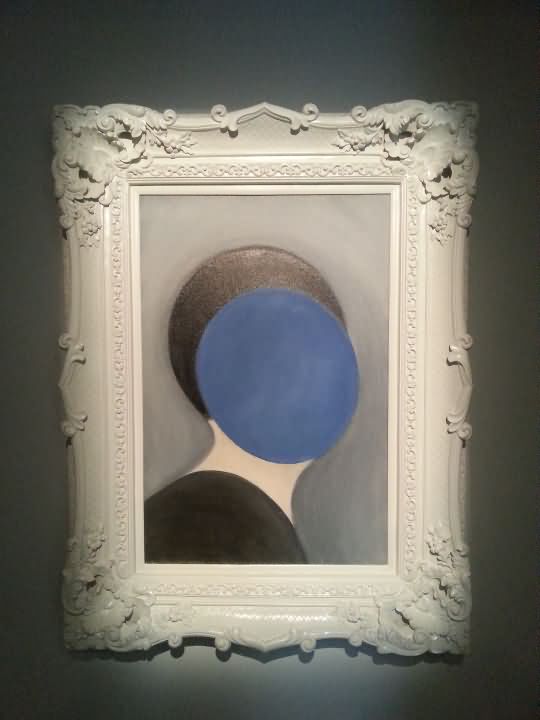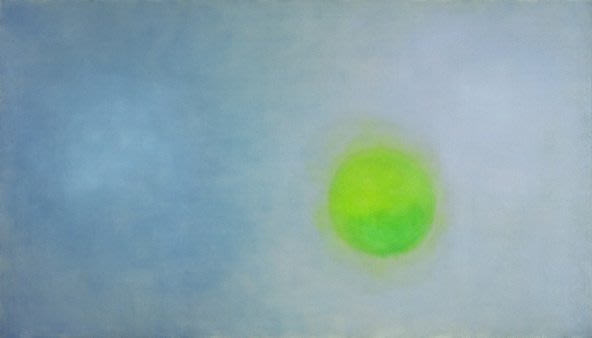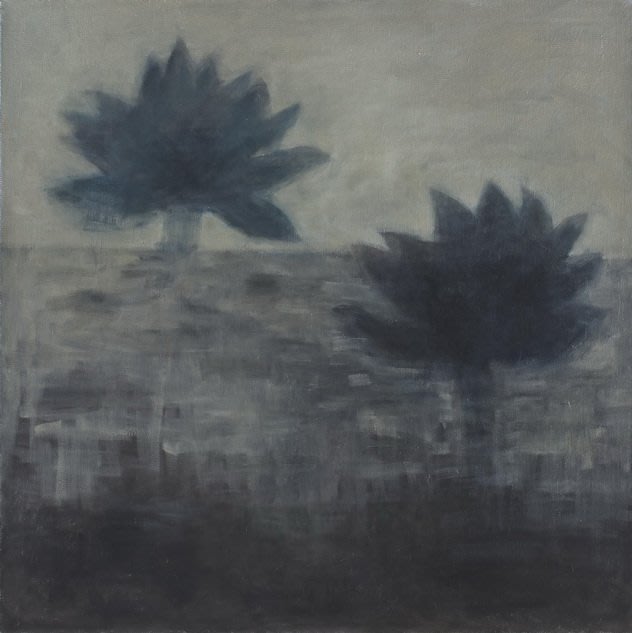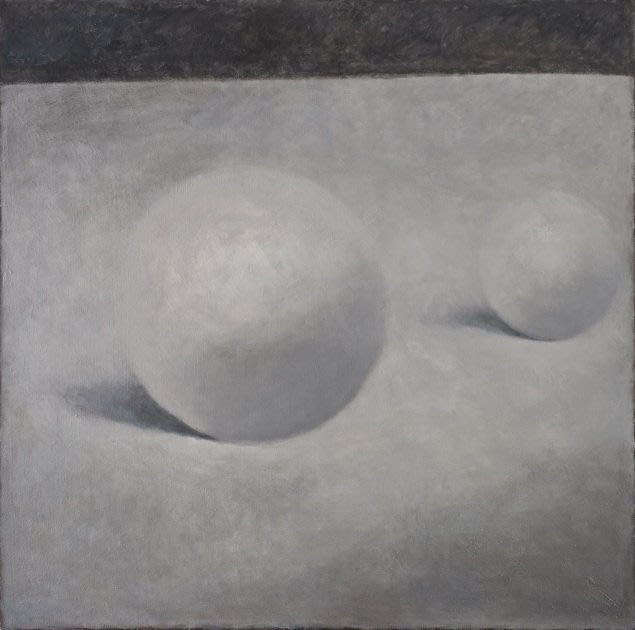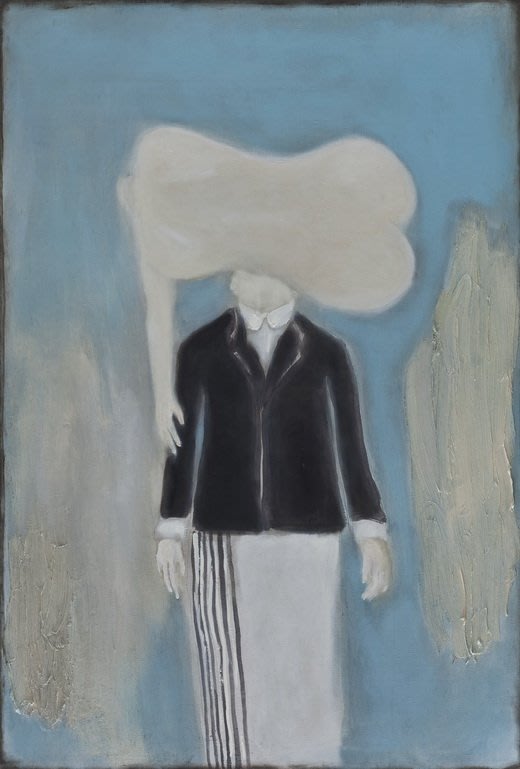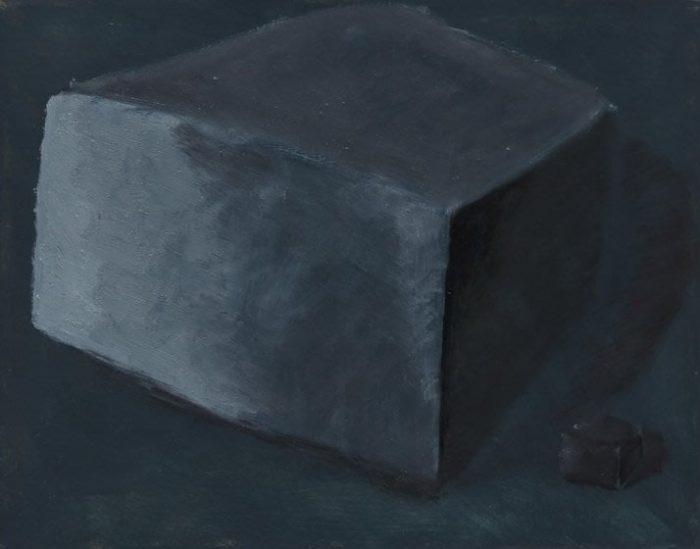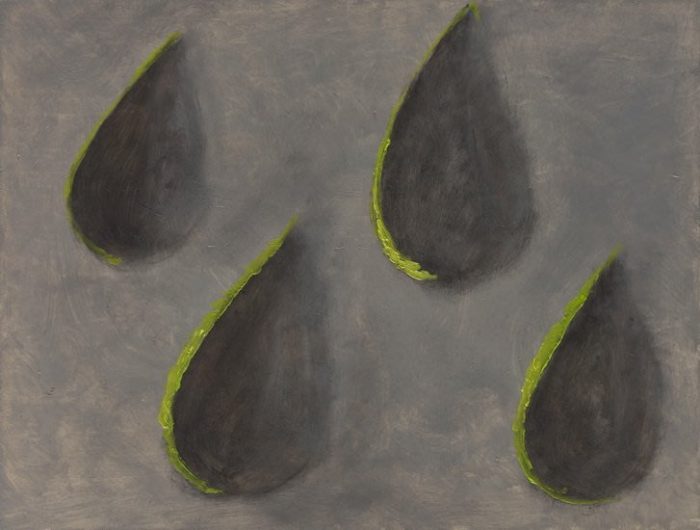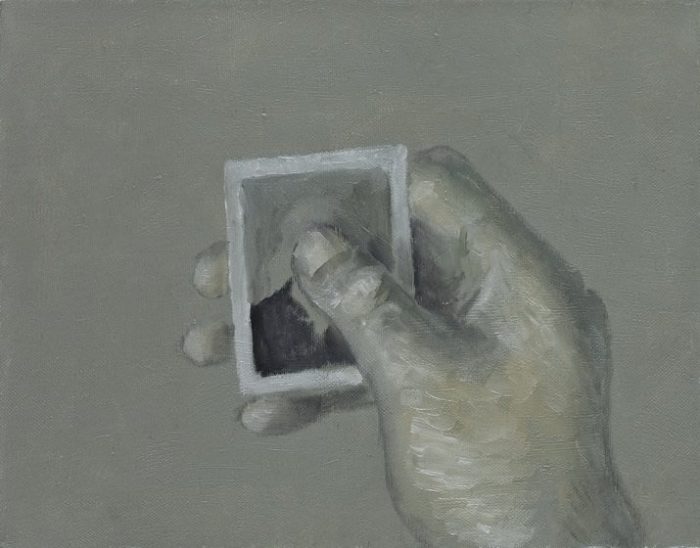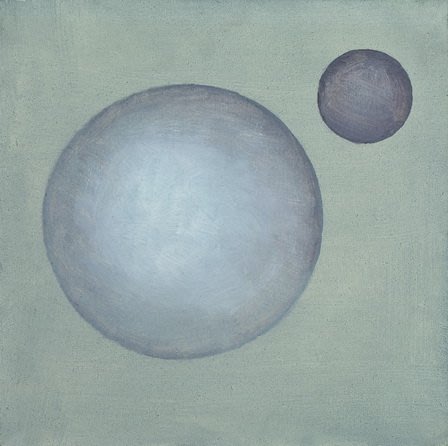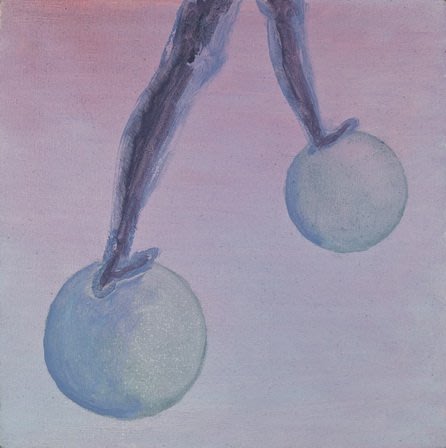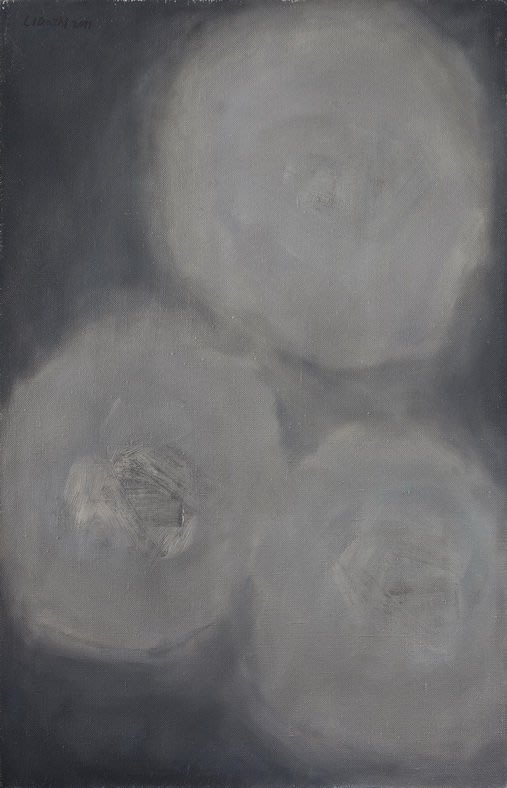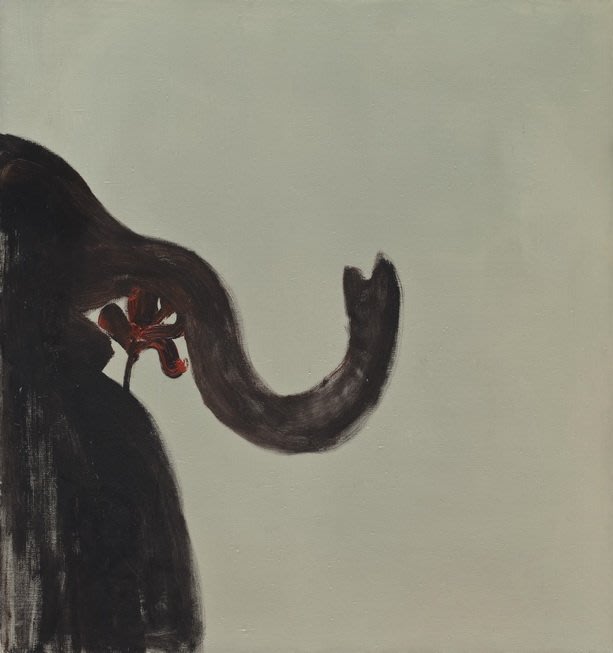LI DAZHI – The Faceless Face
2013.09.22 – 2013.11.20
Press Release
liHeinz-Norbert Jocks
The Faceless Face
An Essay on Li Dazhi’s World of Images
When today, looking back, I try to give an account of the primary impression his paintings made on me during our first encounter in his studio in Beijing over a year ago, then a word like “restraint” spontaneously comes to mind. Yet a concept like “unobtrusiveness” appears to even better suit these paintings, which, upon barely offering themselves to us, already withdraw themselves, as if it is only in this way that the presence of what is depicted there is considerably increased and intensified. Indeed, what is initially the most striking thing about the idiosyncratic way in which Li Dazhi perceives the things he selects is that they announce the unbearable lightness of an inconspicuousness here, and a strict desire for simplicity in the sense of the greatest-possible clarity there. Each merges into the other. Yet nothing is urged on by a stubborn will. Nor does an all-determining intention lurk in the background. And one cannot even begin to speak of an all-advancing concept in a narrower sense. Yet of what can one speak then?
Quite obviously, for Li — who was born in 1968 in Jiamusi, the city located on the central and lover banks of the Songhua River in the northeast Chinese province of Heilongjiang – what matters is not that what we discover in his paintings directly jumps out and reveals itself to us suddenly. Indeed, it rather seems to be the case that he places great value on the slow but steady unfolding of a sustainable effect through the how and what of his representations, including their enabled and released associations. All in all, this does not depend on the discovery or the carving out of a moment, but rather, as we will yet ascertain, the continuity of the process. No focus on the irretrievable here and now; rather the never-ending and the eternally-flowing are decisive for him. As much as this work appears to be associated with or consistent with western art — because it turns its back on a figuration which is generally understandable and familiar to us and employs for itself and uses a style of painting which could be mistaken for the western one — the hardly noticeable differences nevertheless then powerfully come to light. Ultimately, these can neither be skipped over nor bypassed, and, what’s more, they suggest that the aesthetic of the paintings neither focuses on dramatisation nor emphasis nor over-emphasis and also not on any climax or watershed. They follow no dramatic art and no choreography. In addition, the question of the content, as will yet be demonstrated, precedes the form. In doing so, the atmosphere out of which things are imagined plays no small part. For it is this which encompasses and carries everything. So much for a first localisation or assessment.
Instead of employing all possible efforts to overwhelm us with striking, prominent, curious, unusual or outstanding appearances, Li dishes up something completely different and contrary to us. Full of vigour and with verve, he travels to one place and does so in an unmistakeable way along the well-worn paths of the completely banal and every day, so that we involuntarily ask what the ear, the side mirror of a car, the rose, the fork, the potted flower or the burning cigarette should or could possibly say to us. A side mirror is just a side mirror, and a rose is still just a rose, or is this not the case? Why, then, does Li hold before our eyes that which we think we already know? Why does he unnecessarily force a déjà-vu upon us? Is it because, ultimately, it isn’t one after all? If it acts as one, where and why can this be recognised? What goes beyond the emerging/appearing and possibly leads us to something else? Why does his interest in painting kindle in this way on these things of all things, so that he believes he must necessarily bring them into the picture? And if he does not do this with the intention of ennobling them, why then, does he undertake this time-consuming effort, and that in a suppressed chromaticity which radiates everything other than happiness and satisfaction, and rather colours everything with melancholy? What does he promise himself from that? More clarity? Perhaps even steadfastness and more solidity? Is he perhaps someone who approaches painting the way others approach writing? Asked about what painting means to him, he views this activity as a study on the same level as eating and drinking. Painting keeps him alive, and saves him from the boredom which sometimes overcomes him. Asked what painting means to him, he summarises: “If you want to know how I define painting, then I have to confess to you that I have not yet found a definite answer. It simply corresponds to my way of formulating thoughts”. Certainly, Li Dazhi does not paint his pictures in the hope of extending the tempting beauty of the surface by a few further square centimetres. That would presumably be too boring and unassuming for him to be able to existentially justify his actions to himself. Something more serious must be at stake for him here. Even more jarring, is that that which we identify on the paintings does not seldom appear so banal and commonplace that it instantly awakes more indifference than curiosity. In addition, everything seems cloaked in a discrete coat of neutrality. Indeed, somehow, something keeps us at arms-length. Nothing stimulating and also nothing seductive. No colours with a signalling effect either. Neither a spell nor an enthrallment like in the cinema are to be expected. Simply nothing aims at holding our gaze, and nevertheless, an unutterable echo emanates from the things. Something resonates there which cannot be simply dismissed or shoved away or to the side. Because, of their own volition, in the face of the pictures, certain tropisms of seeing and feeling attach themselves to us in a questioning form. We have to pursue them, in order to – with a certain caution – approach that which we, very gradually, step by step, yet suspect beyond what we see. Do the pictures perhaps deal with the expression of a nominal interior which actually coincides with the outer gaze? In any case, this painter does not pursue the encyclopaedic intention of capturing the world along with everything which belongs to it through a, for example, realistically developed style of painting. Li Dazhi is everything but a simple describer of the narrow yet wide world around him. He rather acts as someone who insists on understanding that which has befallen him in his life. In short, it seems as if we are dealing here with a deliberate painter on a quest. Yet what does he seek? What does he want to experience or realise, and what allows him to paint? And how does his research correlate with the allusion to those things which are so restrained that more can be inferred from them than we recognise? God knows, more questions than answers accumulate, and yet one thing is irreducible. Without being occupied, our eyes remain freely and ceaselessly in mobile correspondence with the structures. Coming across meanings in doing so, which, like tea, first have to draw for a certain amount of time and then still always vanish. Li probably also refrains from focussing our attention on something on the grounds that when this is done one forgets that everything is engaged in becoming, standstill is always deceptive, and, ultimately, change is everything.
In a nutshell, the efficacy of his pictures is due to neither a particular conciseness nor any kind of sophistication or aesthetic calculation. So, one searches in vain for a style which holds everything together, and the seductions of the manipulative don’t even arise. Absolutely nothing here is founded on artificial stimulation or artificial heightening of experiences. We are dealing with a quiet praise of unobtrusiveness and along with it, in my opinion, a barely visible but abiding border is drawn against the Western aesthetic. With what the French philosopher and sinologist François Jullien — who spent many years in China — refers to in his beautiful eulogy “Praise of Blandness” and calls “the positivity of blandness”, we can most likely to comprehend what Li Dazhi offers us. The suspicion he has left the East behind him in favour of the West and has absorbed the Western aesthetic is not just invalidated here. No, upon closer examination, such a perspective is proven absolutely untenable and irrelevant. For the closeness to blandness is as evident as the commitment to Buddhism delivered at the very beginning of our conversation.
He rather casually already came into contact with it as a small boy, thanks to his mother. Although in her heart she was a professing Christian, she visited the, at the time, little-frequented, temple complexes in her hometown with her son because no churches existed there. For Li, the atmosphere of the space he perceived in them remains unforgotten to this day; it has deeply impressed itself in his memory and continues to linger in him now. In the silence detached from reality, he experienced not only the unmistakeable time of a different contemplation but also the rare happiness of a possible being-with-himself. Only much later did he grasp the entire importance and magnitude of this first close contact with that which the Buddhist philosophy of living contains. Although already as a teenager he immersed himself in the reading of books which introduced him to these thoughts about death and life, the actual spark only ignited in him during a journey to India, thanks to an encounter with Rinpoche. It was this exchange which became for him a true inspiration, and gradually began to influence his understanding of art and life. Yet that which his older sister told him years earlier, shortly before he was due to take his exams at the Central Academy of Fine Arts, about the power and efficacy of the well-attended Lama Temple Yonghegong in the northeast of Beijing was also not unimportant in his journey towards Buddhism. Even if prayer did not grant him the happiness he had hoped for, and he was not accepted into it, the impression radiating from the place was nevertheless momentous. Because what he strives towards today, without forcing it with all his might, is, as he himself says: “a painting in the spirit of Buddha. I strive to articulate my thoughts as a painter as clearly as possible. It then becomes ever less, and at the end it disappears. When I begin to paint, it is the beginning of something that more and more becomes nothing.”
Incidentally, the more Li elaborates upon his reflections on the blossoming and withering of a flower as an analogy to the emergence and fleetingness of an idea — that is to say, thinking about becoming and passing on in a specific as well as a general sense which now and then encompasses central themes which he also artistically measures, like time, human nature, body and spirit – the much less surprising the sentence interlaced with Buddhism which he ultimately casually drops into his conversation is. “The only thing that prevents me from living life in a monastery is the responsibility that I have for my wife and my children.” As if there was a connection there, he immediately adds that the person who lets himself be ruled by his desires rather than resisting them is already in the process of losing what he covets. At the end of his explanations, which reveal how strong his consciousness is informed by thoughts of Buddhism, he sums up: “Desire as well as expectation place us in a bad and compromising mood. Because they release negative energies. What matters is dealing with this desire in such a way that it doesn’t hinder someone, and I not only believe but also hope I have found a good way for myself.” Listening to him, we sense how much almost everything within him circles around the existential questions “Why do I live in this world?” and “What are the reasons why we exist and what do we do with the fact that we are on this earth with others?” Anyone who, like Li Dazhi, can not only not avoid preoccupation with the fundamental questions of life but also positively seeks them out and forces answers from them, also reacts like someone who in doing so becomes a passionate explorer or investigator, sensitive to the complex phenomenon of time. For it is inevitably the case that he also examines the meaning of life and time in and through his art, that is to say, with the aid of his installations as well as his paintings. Yet how does he achieve this?
Everything but a strategist who focuses on aesthetic effects in a struggle or quest for attention, Li proves to be someone concentrated on the essential, closely connected to the currents of the spiritual, who holds himself back in his work, in short, an artist who dives into the ultimately unfathomable depths of existential experience and creates out of them. As simple as his works appear at first glance, through them he dares to look beneath the apparent surface of things, without pushing this all too much to the forefront. Incidentally, for him, seeing, hearing, remembering, experiencing, feeling and recognition are so intertwined with each other and so interlocked that nothing of them can ever be separated. Before he reaches for paint and brush, he first thoroughly thinks over the question of why he wants to paint this and not something else. And only then, when the reasons sustainably convince him, and the inner urgency which motivates him has taken hold, does he make the decision to begin working.
Generally getting by without preparatory drawing, as it were, painting directly into clarity and distant from all spontaneity, he always limits himself to details or the fragmentary. Indeed, the big picture interests him far less than what is extracted from it, and the individual and small things interwoven through it. So all we see of a white horse is its head, neck and mane. In the truncated side mirror of a car, in which we gaze outside through the perspective of the driver, the heavens and earth with the line of the horizon appear as if out of nothing, but the landscape is not depicted any further. It remains abstract and unnamed. We catch a glimpse of a landscape framed by the mirror, in which all landscapes appear to combine into a general abstraction. An open book, which features no type and bears no title, is so absorbed by the red of the background that it does more than simply mutate into a, as the title of the painting ambiguously suggests “Red Book”. At the same time, the colour threatens to monochromatically redden everything which opposes its flow, as if no other shade was permitted anymore. Absolutely everything is saturated and flooded with this red. Book and background appear as if shortly before their total fusion. The thought can’t be excluded that the course of history is being symbolically commented on here. In the eyes of the painter, a fork bearing traces of use also lends itself to being a motif of no lesser significance than the leaves of a twig. The branches of a tree. A skull bordered by green lines. The head of an insect. The breast of a woman gently clasped by a hand. The face of someone sleeping, who is holding her head with one arm. The cloudy sky alternating between red, blue and grey. A rose with three leaves held in black-grey in front of a green backdrop. A burning cigarette held by the index fingers. The arm of a man stretched out of the water, struggling for help, shortly before drowning. The face of a woman with red lips, whose eyes disappear behind the oversized lenses of a pair of glasses. And the volatility of an outlined figure, from which only the white glasses with a red frame stand out in the space suspended in air, a fetish of memory which arouses no more attention than a self-portrait limited to the area between eyes, mouth and nose. A skull is placed at the side of it as a counterpart in such as way as if in doing so, the time period between life and death should be measured out.
Then there is the black elephant with a flower in its mouth and its trunk raised in the air, which stands for luck, love and strength. It was painted by Li Dazhi after the death of his father, when he felt himself helpless and at the same time like someone locked in a room. In addition, his own situation as an artist had come to a head from one moment to the next. Because there was no longer a market for his installations, he was faced with the prospect of beginning with painting from square one again, and was afraid it would not approach the expressiveness of his installations. Asked about why he turned towards this totemic animal encircled by many myths, he speaks of friends who recognised a white elephant in him, and also of reincarnation in the Buddhist sense. He felt like a white elephant who devours enormous amounts of grass, and therefore no doubt he became in the painting an elephant with a flower in its mouth. That sounds like a projection in respect to his father’s end. Indeed, for Li Dazhi, all life consists of cells, which fall to dust one day. “I know” he emphasises, “that the spirit — that of my father as well –, is somewhere else, and I wanted to offer him a flower as a gift. Insofar, it is a picture of both of us.” This is what he states.
Nearly everything that Li Dazhi paints is preceded by perceptions, experiences, research and complex considerations, for which he searches for subtle visual solutions of the greatest possible simplicity. In doing so, not only the eye but also the ear is an organ of perception for him, with which we people register the wealth of the outside world. “When I began to paint interior images, that is, images which originate from the spirit, I thought about what it means to see with the eyes and to hear with the ears. I asked myself how the spirit, the ear and the eyes communicate with each other, and eventually came to the conclusion that the spirit draws on the experiences which our eyes and ears as well as our hands and feet make. Hence, “body and spirit are related to each other”. The pictured ear here proves itself a literal embodiment of a compressed memory. Alongside it, a cut-off thumb has erected itself like a sculpture as tall as a man. Placed on the left edge of a space consisting of ground and background, gliding between blue and grey in colour. The image of this finger from the year 2009, which, according to the format of the picture nearly reaches the body size of the artist, and which has transformed itself into an independent figure in the room, leads us to ponder what has possibly moved Li Dazhi to focus on the mere presentation of a body part. Thanks to its separation, it becomes an autonomous image. However, detached from the body, on no account does the thumb appear the bloody victim of an amputation. Rather, it is a loose thing in itself offered up to us, extremely mysterious in its isolation. It makes us think more of estrangement than of alienation. In any case, the image of the obscure enthronement of the thumb provokes a shock of alienation in us. One feels oneself reminded of the situations when one stares at one’s own finger as if it were something strange and detached from oneself, as if one is posed the peculiar question, whether this thing here really belongs to us, and what it is capable of revealing about our existence. The thumb becomes a target of an urgent perception which has lost sight of coherence and has hidden something individual away from the whole. As in that bitter moment in which, amidst an encroaching doubt one seeks to affirm one’s presence in the world. An expression like the loss of reality could serve as a key to its interpretation. Whether through it we ignore the meaning of the painting, or bypass it by a hair’s breadth remains unclear. Yet the interpretation is no less absurd than the question is obvious: what could possibly have been going on in Li Dazhi’s mind when he separated the thumb from the body, to display it like a thing? The whole image is similar to a post-operative situation, in which the finger has made itself independent. In light of that which is horizontally positioned one would equally involuntarily like to find out whether it is about the thumb of the painter or that of someone else. What is possibly so special about it, that he allows it to appear completely alone on the stage of the painting? And why does he enlarge it so much that it somehow enters into a relationship with us at eye-level? Because it has taken the place of a human figure and its reduction to a single body part has become an expression of a human mental state? What does this shortening reveal about the whole person? One can perhaps summarise: the one who has been crippled into a thumb is the person who no longer experiences himself in his entirety, but rather feels like an individual finger, which has been cut off from his body. Without dramatising this pain, which is secretly elevated to the precarious subject here, Li Dazhi plays on a situation in which a person has fallen out of harmony with himself and the world, and the perception of his own body has focused itself on a ridiculous finger. But how did this come about? How did it occur? What happened in his life? The reference to the death of his father at the time the painting was created is also revealing here. “When my father was still alive, but already close to death due to his illness, I set off for India. Because I didn’t have any real understanding of death, I thought I could gain essential experience there, which would help me to somehow understand the sheer incomprehensible and inconceivable. Yet when my father eventually died, I felt nothing but grief and above all pain, nothing but pain. I felt as if my finger had been hacked off without any anaesthesia whatsoever and with the greatest violence. I could neither accept nor get over the separation when my parents and my closest friends left me. I felt like someone abandoned by the entire world and all of his senses, and in addition, I had also previously experienced the weakness and powerlessness of people around me. Reality revealed itself to me in its complete cruelty. I carried this terrible feeling in my heart, like a stone which had become far too heavy for me.” Only gradually did Li Dazhi find a connection again to the outside. Indeed, out of what he indicates one can infer how strongly he was struck by the force of the paralysis which overtook him then. He freed himself from it through the help of painting. There is no doubt that Li Dazhi requires such an impetus for every work he creates. That every work touches an intersection of his existence. That everything which he paints is a symbol of his life. Nevertheless, the paintings are not connected to any specific, clearly decipherable meaning. Their openness, the radical refusal to reduce a work down to a clear emerging meaning are linked to a thought process which is permanently in flow. With Li Dazhi this reaches a monstrous simplicity of expression in his painting. All in all, the gaze into the interior which Li Dazhi affords us through detours is always immediately negated. Although events and experiences form the underlying background of his paintings, his concern is not to display clues for our later investigations. Let us take for example the faceless face from the year 2008, enclosed in an old frame. In front of us, a head with shoulders, whose visage is missing its eyes, nose and mouth. Everything which would allow and facilitate an identification is not only consciously omitted, but in addition also covered with a grey circle. Through it, we don’t even yield to the temptation to fill the gaps through our imagination. But let us listen to what he himself says about this painting. Before he started the portrait, he so happened to discover a photo frame in a gallery in Hong Kong, which was furnished with a landscape, although it had been produced for portrait prints. He bought the frame with the intention of creating the portrait of a face for it. Confronted with this anonymous image without a facial expression, we inevitably think of the history of portrait painting as well as the tendency of the painter to coax out what is special in a personality through the sketching of eyes, ears, mouth and nose. Neither tears nor a smile, absolutely nothing that could grant the facial expression something like an essence, can be admired here. It would arguably be completely wrong if we would speak of a generalisation here. A term like simplification also misses the point. Through Li Dazhi evoking a face which does not correspond to any concrete one, and nevertheless insisting that we are dealing with a human visage which remains hidden from us, it again becomes possible for us to catch a glimpse of something in him. Neither age nor sex can be determined, and nor can any individual features be discerned. The circle which marks the omission and replaces the face acts like a plugged hole. But also like a blind stain or a dirty mirror. We look at the face, which has similarity with no one, as everything face-like has been expunged, and we ask ourselves what it stands for, when it provides us with information about nothing and no one. Our gaze glides away from the face without discovering anything that allows us to draw conclusions. Instead of coming across lines which reflect something, we come upon an impenetrable surface. The facelessness offers resistance. It eludes our forensic attempts to nail down a person forever in terms of fixed characteristics or an essence on the basis of his facial features, which no being precedes. Subject to the endless flow of time like everything else with Li Dazhi, the face escapes the danger of freezing. Since it is constantly changing, it cannot be fixed in any one moment. In addition, the painting has to do with the fact that faces lie. They can mime sadness although they are happy, and radiate cheerfulness even though it is dark inside. Insofar, Li Dazhi has doubts about that which we understand under the authentic expression of a face. Yet also here, far from everything is said.



